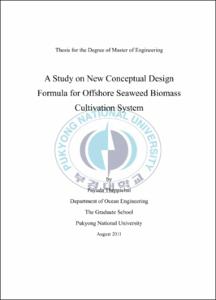A Study on New Conceptual Design Formula for Offshore Seaweed Biomass Cultivation System
- Alternative Title
- 외해 해조류 바이오매스 생산시스템에 대한 신개념설계공식에 관한 연구
- Abstract
- An attention and attempting utilize seaweed biomass as an energy resource is increasing in many countries over the world. The idea of using marine biomass for energy was first conceived by Howard Wilcox in 1968 (Chynoweth, 2002). According to the increase in demand of this eco-friendly energy, the mass seaweed cultivation in offshore was considered. Many researchers have studied the effects of physical and biological in seaweed cultivation system (Neushul, 1992; Choi et al., 2006). However, there is still lack of both design plans for installation and construction of seaweed biomass cultivation in offshore. This study aims to make conceptual design for seaweed cultivation system by using the results of existing research and designing new formula for cultivation system in offshore together with using hydrodynamic and biological factors. Firstly, the research of offshore seaweed cultivation system and environmental condition in global and Korea were reviewed to understand several designs and methods of seaweed cultivation system in different conditions. Then the relationship of environmental factors and the analysis of physical conditions in Korea sea area, using filed observation and numerical simulation, were investigated. The result of environmental factors showed that water temperature was between 6.5°C-25.0°C in Wando station, in Gijang station was between 12-27°C. The result of salinity was ranged between 31-35‰ in Wando station which is smaller than in Gijang station. The results of temperature and salinity in both of station were corresponding with an existing research on growth of seaweed. In addition, field observation results in Gijang station presented the range of maximum wave height(Hmax), mean wave period(Tmean), maximum current velocity(Vmax) is 8~9 m, 6~8 sec, 55 cm/sec and in Wando station is 4~5 m, 4~8 sec, 40 cm/sec, respectively. These results were consistent with the results from numerical simulation on wave and current. Finally, our study estimated schematic form of conceptual design and a new formula for seaweed cultivation system.
- Issued Date
- 2011
- Awarded Date
- 2011. 8
- Type
- Dissertation
- Publisher
- Pukyong National University
- Affiliation
- Pukyong National University
- Department
- 대학원 해양공학과
- Advisor
- Heon-Tae Kim
- Table Of Contents
- CHAPTER 1 INTRODUCTION 1
1.1 Background 1
1.2 General seaweed productivity 3
1.3 Study Objectives 6
CHAPTER 2 DATA AND METHODS 9
2.1 Offshore seaweed biomass systems 9
2.1.1 Conventional long-line system 11
2.1.2 World research 11
2.2 Design factors 17
2.2.1 Environmental conditions 17
2.2.2 Physical conditions 22
2.3 Existing design formula of biomass system 24
2.4 Method of new formula for making concept 31
2.4.1 Field observation 31
2.4.2 Numerical modeling 32
CHAPTER 3 RESULTS 36
3.1 Relationship between environmental factor and growth 36
3.1.1 Temperature and salinity 36
3.1.2 Nutrients 39
3.2 Analysis of physical conditions 44
3.2.1 Wave 44
3.2.2 Current 48
3.3 New Design formula by concept factors 53
CHAPTER 4 CONCLUSIONS AND DISCUSSION 56
REFERENCES 58
ACKNOWLEDGEMENTS 63
- Degree
- Master
- Files in This Item:
-
-
Download
 A Study on New Conceptual Design Formula for Offshore Seaweed Biomass Cultivation System.pdf
기타 데이터 / 4.4 MB / Adobe PDF
A Study on New Conceptual Design Formula for Offshore Seaweed Biomass Cultivation System.pdf
기타 데이터 / 4.4 MB / Adobe PDF
-
Items in Repository are protected by copyright, with all rights reserved, unless otherwise indicated.